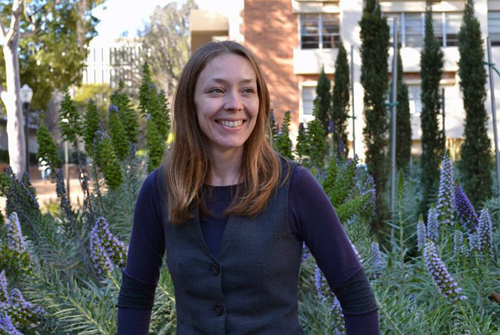
For thousands of years, civilizations have been building monuments that they hoped would endure long past their own lifetimes. Think of the pyramids, Stonehenge and the Eiffel Tower. But now, says art history professor Amanda Boetzkes, the enduring monument has become pathological: our civilization is producing tonnes of garbage that will still be around for thousands of years.
Boetzkes is currently writing a book that looks at the debris we leave behind and what artists are now doing to turn this garbage into art. “I approach art history through cultural theory,” she says. “Art is about the way we make sense of the world through images and objects.” While artists have been reusing discarded materials in their projects throughout history, it makes sense that the use of garbage is increasing at a time when waste disposal has become a growing problem.
“Garbage has become a major issue for every big city,” says Boetzkes. “New York City ships garbage to four other states, paying them for the privilege of dumping it there.”
In the 1960s and 1970s, she says, most art that used discarded items focused on degraded materials that looked dirty and unrefined. Today, art made from garbage tends to use bright, fluorescent plastics. “The esthetic paradigm has changed,” says Boetzkes. “Art is starting to look like shopping, an accumulation of commodities.”
Boetzkes joined U of G in 2012. She was born and raised in Edmonton and did her undergraduate degree at the University of Victoria , moving to McGill University for graduate school and working on a post-doc at Harvard University. “In my undergraduate degree, I started out with an interest in Chinese and Buddhist art, but after taking a few courses in modern art I fell in love with it,” she says. Her fascination with art history has meshed with a passion for environmental and ecological issues.
After her post-doc, Boetzkes became an assistant professor of art and design at the University of Alberta and wrote her first book, The Ethics of Earth Art. “The idea of earth art started in the 1960s with sculptures built into the land,” she explains.
“It’s a shift from the concept of art as an object to art as a space that people can enter, a space that changes with weather and time. One example is sculptor Robert Smithson’s Spiral Jetty, which was created using soil and rock molded into a spiral shape in the Great Salt Lake in Utah.” This massive sculpture becomes submerged when the water level rises and emerges coated with crystallized salt when the water goes down again.
“This kind of art makes a statement about not controlling the art object and about nature existing beyond our human control,” she adds.
Boetzkes recently co-edited a second book, published in 2014, which is a collection of essays titled Heidegger and the Work of Art History. The essays “probe the importance of German philosopher Martin Heidegger’s writings for art history and visual culture,” she says. “His work is about the question of being, and one thing he discusses is the place of art in our experience of being.”
Her current interest in the use of garbage in art will form the basis for a new book, currently titled Contemporary Art and the Drive to Waste. In her writing she hopes to explore what garbage means to us and how we experience it, how artists change garbage and what their perspectives tell us.
“I was surprised when I started this project to discover the work of archeologist William Rathje, who excavated a landfill in Tucson, Arizona. He discovered that our beliefs about the garbage we produce are very different from reality,” says Boetzkes.
Rathje found that food waste was actually the largest component of the landfill; plastic only made up a small percentage. Since landfills are covered over and sealed from the air, even the biodegradable components don’t break down quickly.
That approach preserves garbage, she says, but artists want to use it to make a statement. Boetzkes says that the crux of Contemporary Art and the Drive to Waste is the dilemma we face: what does the repositioning of garbage as art mean at a time when art has lost the ability to criticize the mainstream aesthetic of the market?